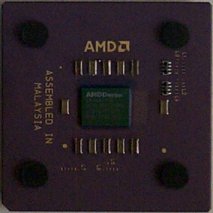Followup to Unlocking Duron
Posted by Wesley on
Followup article, Unlocking Aftermath and Overclock is up for your viewing. See how far I had pushed my now-unlocked Duron.
 | Remember this chip from my previous article? This is a Duron 650MHz. I chose Duron over Thunderbird because of overclockability. The high quality of the AMD chips ensure a fair amount of overclocking already, but Duron's default voltage is 1.5V as opposed to Thunderbird's 1.7V. Since the maximum voltage setting for Socket A is generally 1.85V, Duron has better headroom for overclocking as higher voltage generally helps the chip operating in higher speed provided that a suitable cooling solution is present. Many hardware sites have confirmed that this voltage headroom does indeed help Duron become a good overclocking chip, getting more than 200MHz faster speed in most cases. |
| CPU: | AMD Duron 650MHz |
| M/B: | Asus A7V (KT-133 Chipset) |
| Cooling: | Alpha PAL6035MUC Fan/Heatsink |
| RAM: | 128MB x 2 Hyundai PC-133 SDRAM |
| Video: | SUMA GeForce2 GTS 32MB |
| OS: | Windows 2000 SP1 |
| Else: | Classified ^_^ |
| Speed | Config | Voltage | Status |
|---|---|---|---|
| 650MHz | 100 x 6.5 | 1.50V | Perfect |
| 700MHz | 100 x 7.0 | 1.50V | Perfect |
| 735MHz | 113 x 6.5 | 1.50V | Good |
| 750MHz | 100 x 7.5 | 1.50V | Boot Stop |
| 800MHz | 100 x 8.0 | 1.50V | POST Stop |
| 800MHz | 100 x 8.0 | 1.70V | Perfect |
| 850MHz | 100 x 8.5 | 1.80V | Perfect |
| 1000MHz | 100 x 10.0 | 1.85V | No POST |
| 950MHz | 100 x 9.5 | 1.85V | POST Stop |
| 900MHz | 100 x 9.0 | 1.85V | Good |
| 910MHz | 107 x 8.5 | 1.85V | Good |
| 892MHz | 105 x 8.5 | 1.80V | Boot Stop |
| 892MHz | 105 x 8.5 | 1.85V | Perfect |
| Benchmark | 650MHz | 892MHz | Change | |
|---|---|---|---|---|
| d.net client | RC5 Long, core#6 (MKeys/s) | 2.230 | 3.083 | +38.3% |
| Sandra 2000 7.6.49 | Dhrystone (MIPS) | 1855 | 2545 | +37.2% |
| Whetstone (MFLOPS) | 876 | 1241 | +41.7% | |
| MMX (it/s) | 2150 | 2960 | +37.7% | |
| 3DNow! (it/s) | 2751 | 3781 | +37.4% | |
| Memory ALU (MB/s) | 423 | 442 | +4.5% | |
| Memory FPU (MB/s) | 531 | 553 | +4.1% | |
| Benchmark | 650MHz | 892MHz | Change | |
|---|---|---|---|---|
| 3DMark 2000 | Overall (1024x768 16bit) | 3975 | 4665 | +17.4% |
| Quake3 Arena v1.11 (fps) | 640x480 HQ | 98.5 | 116.2 | +18.0% |
| 800x600 HQ | 96.1 | 110.7 | +15.2% | |
| 1024x768 HQ | 83.0 | 86.3 | +4.0% | |
| 1280x1024 HQ | 50.0 | 50.2 | +0.4% | |
| 1600x1200 HQ | 33.4 | 33.4 | 0.0% | |
| This is what Hard|OCPer Patrick has to say about the Unlocking the Socket A CPUs with a Pencil. Just wanted to let you know, that you can unlock the TBird w/ a normal #2 pencil by just going over the L1 bridges a few times. I got mine in yesterday, and it worked perfectly. Just thought I would let ya know it worked... Then just when you thought you have heard the last of it. (which I seriously doubt) Another Hard|OCPer busts out with incredible close-ups of his mechanical pencil microsurgery. Don't you need a license for that??
|